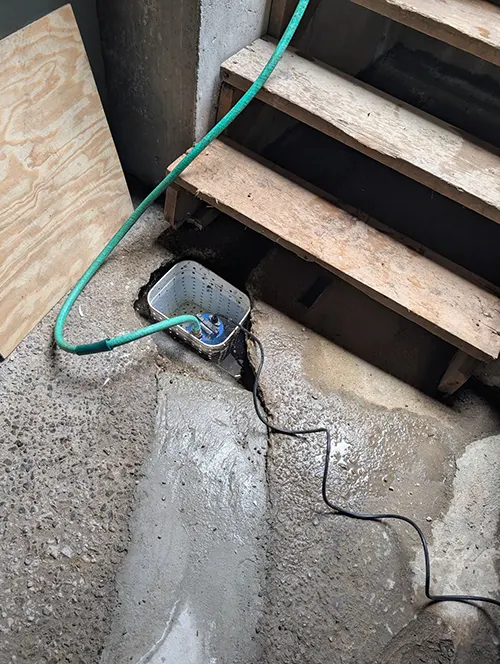
In this episode, Adam explains why a DIY sump pump job should be considered temporary, at best. Something like that should be left to the pros.
Narrator: It’s time once again for the “Crack Man Podcast” hosted by A1 Foundation Crack Repair. I’m Darren Kincaid here with the Crack Daddy himself, Adam Tracy. Adam and The Crack Man Rich have over 30 years’ experience in the construction industry. Rich as over two5 years as the president and founder of A1 Foundation Crack Repair. This podcast provides expert basement waterproofing, concrete repair, and preventative maintenance tips for homeowners and businesses. A1 Foundation’s valuable insight will help avert a disastrous flood within the basement, health problems associated with water infiltration, and protect your biggest investment….your home. The topic of today’s podcast: Can you DIY a sump pump job in a leaky basement?
Narrator: So, Adam, you sent a picture of this little sump pump sitting in a sieve with a garden hose running out of it as a drain. The homeowner called you, so I'm guessing this simple DIY fix wasn't getting the job done. Right?
Adam: Yeah. That's right. This photo is not a unique photo that we get when it comes to sump pump installations. We get a lot of phone calls from customers. This customer happened to be in the Worcester area, but honestly, it doesn't matter anywhere you are. If you have a water table problem, a sump pump might be your best line of defense against it. Unfortunately, a lot of people will try to attempt to put these in, or maybe they'll hire a friend or family or plumber, and you get these solutions, quote, unquote, that are definitely substandard.
This particular case comes out of Worcester, Mass. The customer calls us up and says, hey, you know, I'm getting water in my basement area. It's coming up through the floor. We're having troubles. We're not sure why it's coming in. I have a sump pump installed. It should be taken care of, but I don't know why it's not. And so my first question is, okay. Well, what do you have installed?
They were able to send us these photos to give us some idea of what was installed. And an all too familiar site came into view, and it was what we call the puddle sucker, which is just a very low volume water removing device that will send water out of the like, a top coat or a top area, and it just you plug it in, and it sends it through a garden hose outside. And the problem is that the water table rises, and there's so much volume of water underneath the house that there’s really not enough proof to get it out.
I try to tell people it's like trying to drain a pool with a garden hose versus trying to drain a pool with a fire hose. Right? You can just move more volume with a larger pump and a better installation. So, what should a sump pump look like? What should your installation look like? Well, number one, it needs to be on a contained base. It can't just be in a mud pit, and it can't just sit there with hot lips collecting around it during the dry period.
It should be in a sealed basin with crushed stone around there to help filter out any sediments that come into the sump pump pit. Because a lot of pump failures happen when the sediments come into the sump pump pit and block the impellers of the pump. So you want to make sure that the stones around this thing help drain it. And then the second thing is you need to have an adequate pump. You know, putting a $75 or $50 puddle sucker in there is just not going to move the water out there. It's not even worth putting the money in there. Good for a little secondary to help with some areas if it's coming in. But for your main workhorse, you need to have a workhorse motor and a workhorse pump.
Having a concealed basin, having an adequately sized pump, and then having it permanently plumbed outside so you're not running the garden hose through the bulkhead, which is going to be open, allowing more water to come in. So, you want to have it permanently plumbed outside, discharging it into a safe area so you're not just recreating the cycle of water coming through the foundation.
While uncle Joe and your neighbor might be good at handyman and YouTube searches to find out how to put these in, the reality is a properly installed sump pump is going to save you so many more headaches down the line because these homegrown solutions, while very creative, generally don't hold up very long. And if those big events come in, you are going to wonder why you have inches of water in your basement. It's usually because it was not properly installed. So make sure you talk to somebody like us who does sump pumps daily here, be able to help you out. So that way, you know, you have a properly installed pump so you can be worry free through all rain events.
Narrator: Thanks, Adam. For explaining why a DIY sump pump job should be considered temporary only. Something like that should be left to the pros and maybe not to Uncle Joe.
Narrator: If you have a basement water problem and think you need a crack professional near Worcester, MA, or, if you’d like more information on foundation crack repair and basement waterproofing topics, please visit A1FoundationCrackRepair.com or call (866) 929-3171. Or you can email info@a1foundationcrackrepair.com. Thanks for listening and keep that basement dry.

